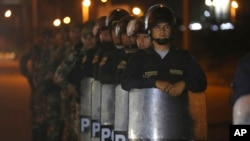Ecuador will launch a new prevention and assistance plan focused on sexual and labor exploitation victims, where hundreds of human trafficking survivors have been rescued in the past two years, a top government official said.
While authorities have saved 332 trafficking victims since 2017, the U.S. State Department kept Ecuador on a watch list this year, saying more needed to be done and noting investigations, prosecutions and convictions were lower last year than in 2017.
"In Ecuador, there's primarily internal trafficking," said Tomas Guayasamin, the head of the government's anti-trafficking and migrant smuggling prevention group at the interior ministry.
Many victims were women forced into prostitution by people they knew.
"The perpetrators of this crime are usually people from (a victim's) family or social environment, and do not necessarily meet all the elements to categorize them as trans-national organized crime," he told Thomson Reuters Foundation late Tuesday.
The anti-trafficking plan, set to run through 2030, will be launched within weeks, Guayasamin said while not detailing whether additional funding or resources will be allocated.
The plan outlines priorities to tackle and monitor trafficking and calls on authorities to improve how they work together, implement programs and allocate resources.
The U.S. State Department said in its latest human trafficking report more work was needed to combat sex and labor trafficking, particularly in Ecuador's coastal cities.
In 2018, authorities started 139 investigations into alleged human trafficking crimes, down from 171 in 2017, while 18 suspected traffickers were arrested compared with 44 in 2017, the U.S. report said.
Guayasamin said a key challenge is training prosecutors to identify and investigate human trafficking cases, as well as how to deal with survivors.
"Prosecutors need to master specialized techniques," he said.
Guayasamin also noted a lack of dedicated shelters for male victims and those who have suffered forms of human trafficking other than sexual exploitation.
Indigenous people at risk
Poor, uneducated and unemployed women and girls from rural indigenous communities are most vulnerable to traffickers' false promises of money and a better life, Guayasamin said.
Indigenous people make up about 7% of Ecuador's more than 16 million population, with 14 different indigenous groups ranging from the Amazon jungle to the Andean highlands.
"In the Sierra Norte region, many indigenous communities, including children, are victims of deception," Guayasamin said.
"The captors promise an economic bonanza and a better future.”
Better social services are also needed, he said, including schools and health clinics in trafficking hotspots, "to prevent the recruitment of people living in vulnerable conditions.”
Guayasamin said that ensuring victims of trafficking can rebuild their lives and get economic reparations is another priority.
The interior ministry is backing a bill before Ecuador's congress to make it easier for authorities to seize traffickers' property and assets, with proceeds going towards a victims' compensation fund.
A similar bill was passed in Argentina in June.





